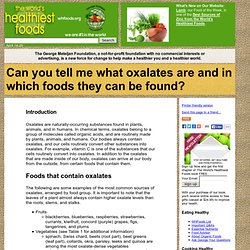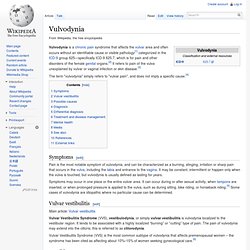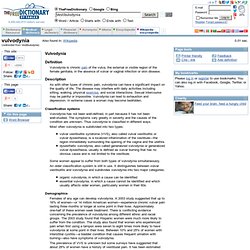

Can you tell me what oxalates are and in which foods they can be found? Introduction Oxalates are naturally-occurring substances found in plants, animals, and in humans.

In chemical terms, oxalates belong to a group of molecules called organic acids, and are routinely made by plants, animals, and humans. Our bodies always contain oxalates, and our cells routinely convert other substances into oxalates. For example, vitamin C is one of the substances that our cells routinely convert into oxalates. Vulvodynia. Vulvodynia is a chronic pain syndrome that affects the vulvar area and often occurs without an identifiable cause or visible pathology[1] categorized in the ICD-9 group 625—specifically ICD-9 625.7, which is for pain and other disorders of the female genital organs.[2] It refers to pain of the vulva unexplained by vulvar or vaginal infection or skin disease.[3] The term "vulvodynia" simply refers to "vulvar pain", and does not imply a specific cause.[4] Symptoms[edit] Symptoms may occur in one place or the entire vulvar area.

It can occur during or after sexual activity, when tampons are inserted, or when prolonged pressure is applied to the vulva, such as during sitting, bike riding, or horseback riding.[5] Some cases of vulvodynia are idiopathic where no particular cause can be determined. Vulvar vestibulitis[edit] Vulvodynia Treatment. Vestibulodynia - definition of Vestibulodynia in the Medical dictionary. Vulvodynia Definition Vulvodynia is chronic pain of the vulva, the external or visible region of the female genitalia, in the absence of vulvar or vaginal infection or skin disease.
